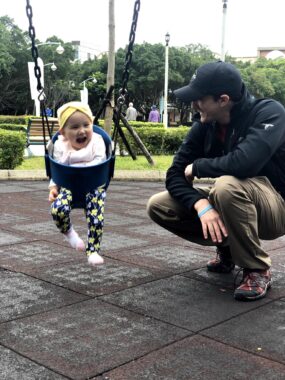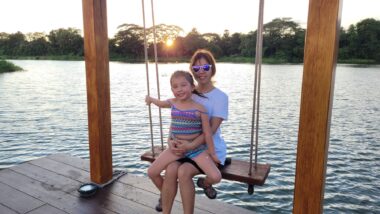How swinging became an early part of our daughter’s therapy
The playground activity was beneficial to sensory integration and relaxation
Written by |

I placed travel neck pillows around my daughter, Rylae-Ann, to make sure she was snug in the swing. I slowly began to push her. Immediately, she started snorting and giggling.
Rylae-Ann didn’t have much of a choice about going on the swing at the time. There was little she could do to protest if she had wanted to because of her rare disease, aromatic l-amino acid decarboxylase (AADC) deficiency. This neurotransmitter disorder robs children of the joys of childhood and makes them unable to move, among many other severe symptoms.
Being locked in her body is what made the swing such a freeing experience for her. It gave her a glimpse of what it felt like to move. She could see the world instead of looking up at a ceiling. At the time of her first swing ride, we didn’t even know the cause of her limitations. What we did know was that when she was swinging, she was happy.
Later, we learned that swinging offered more benefits than just smiles. These benefits, which I’ll list below, helped her make important developmental advances.

Richard E. Poulin III watches his daughter, Ryale-Ann, swing, prompting giggles and laughter. (Courtesy of Richard E. Poulin III)
Sensory integration
I often write about sensory integration, but not because I think it’s the most important paramedical treatment. Rather, it’s because I initially discounted it and later realized it was an integral part of a holistic approach to caring for Rylae-Ann.
Swinging affects the body’s internal processing system that controls movement and balance, known as vestibular input. Swinging pushes the body to become more aware and forces it to adjust balance, spatial awareness, and coordination.
Relying on daily activities that neurotypical children do was not an option for Rylae-Ann. Instead, we used swinging to engage the muscles she did have during an activity she enjoyed.
Relax and unwind
Although the visit to the swings started with excitement, I noticed that she calmed down after a few steady swings. The rhythmic and repetitive swinging motion calmed down her nervous system. This is particularly beneficial for those who may be easily overstimulated or have difficulty self-regulating.
Because Rylae-Ann couldn’t communicate what she wanted or how she felt during the day, she would only cry. Her crying fits were very taxing on all of us. Being in the swing and traveling through different planes of motion relaxed her and allowed her to understand her spatial awareness better.
Focus and coordination
Rylae-Ann’s eyes were noticeably alert. During the day, an autonomic dysfunction known as ptosis left her eyes in slits and looking drowsy. On the swing, her eyes began to open. It looked like a cup of strong coffee had just kicked in.
Swinging at the playground required Rylae-Ann to summon her muscles to coordinate movements that switched as she moved to and fro. Feeling off balance was a strange but delightful experience for her. The sensory input helped improve her focus and attention.

Today, Rylae-Ann enjoys sharing a swing with her mom. (Photo by Richard E. Poulin III)
Not all children respond the same way to swings, and they are not required for sensory integration. The idea is to find an enjoyable family activity and then adapt it to meet your child’s therapy goals. What the high-flying, swinging Rylae-Ann is doing today completely differs from how we started five years ago. It was a slow and gradual process.
For Rylae-Ann, the first swings probably felt similar to what I would feel on a roller coaster ride. Take it slow, and let the giggles guide you.
Note: AADC News is strictly a news and information website about the disease. It does not provide medical advice, diagnosis, or treatment. This content is not intended to be a substitute for professional medical advice, diagnosis, or treatment. Always seek the advice of your physician or other qualified health provider with any questions you may have regarding a medical condition. Never disregard professional medical advice or delay in seeking it because of something you have read on this website. The opinions expressed in this column are not those of AADC News or its parent company, Bionews, and are intended to spark discussion about issues pertaining to aromatic l-amino acid decarboxylase deficiency.






Leave a comment
Fill in the required fields to post. Your email address will not be published.